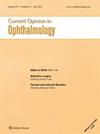人工智能在儿童近视中的应用:当前趋势与未来方向。
IF 2.6
2区 医学
Q1 OPHTHALMOLOGY
引用次数: 0
摘要
综述目的 近视是全球视力损伤的主要原因之一,近视及其并发症给医疗保健和经济造成了沉重负担。由于大多数近视病例都是在儿童时期形成的,因此尽早实施干预措施以减缓近视的发展最为有效。为了应对这一公共卫生挑战,人工智能已成为儿童近视管理的潜在解决方案。最近的发现儿童近视方面的人工智能研究主要集中在传统的机器学习模型上,用于识别近视发展的高风险儿童。最近,大量文献利用更大的数据集、更强的计算能力和更复杂的计算模型,将人工智能用于新方法,包括利用大数据、多模态数据和先进的成像技术进行大规模近视筛查,以确定近视发展情况,以及利用深度学习模型进行精准治疗。包括自动机器学习、大型语言模型和联合学习在内的新型人工智能模式可通过提供精准医疗、提高健康素养和保护数据隐私在未来发挥重要作用。然而,伴随这些技术进步而来的是监管和临床整合等实际挑战。本文章由计算机程序翻译,如有差异,请以英文原文为准。
Artificial intelligence in myopia in children: current trends and future directions.
PURPOSE OF REVIEW
Myopia is one of the major causes of visual impairment globally, with myopia and its complications thus placing a heavy healthcare and economic burden. With most cases of myopia developing during childhood, interventions to slow myopia progression are most effective when implemented early. To address this public health challenge, artificial intelligence has emerged as a potential solution in childhood myopia management.
RECENT FINDINGS
The bulk of artificial intelligence research in childhood myopia was previously focused on traditional machine learning models for the identification of children at high risk for myopia progression. Recently, there has been a surge of literature with larger datasets, more computational power, and more complex computation models, leveraging artificial intelligence for novel approaches including large-scale myopia screening using big data, multimodal data, and advancing imaging technology for myopia progression, and deep learning models for precision treatment.
SUMMARY
Artificial intelligence holds significant promise in transforming the field of childhood myopia management. Novel artificial intelligence modalities including automated machine learning, large language models, and federated learning could play an important role in the future by delivering precision medicine, improving health literacy, and allowing the preservation of data privacy. However, along with these advancements in technology come practical challenges including regulation and clinical integration.
求助全文
通过发布文献求助,成功后即可免费获取论文全文。
去求助
来源期刊
CiteScore
6.80
自引率
5.40%
发文量
120
审稿时长
6-12 weeks
期刊介绍:
Current Opinion in Ophthalmology is an indispensable resource featuring key up-to-date and important advances in the field from around the world. With renowned guest editors for each section, every bimonthly issue of Current Opinion in Ophthalmology delivers a fresh insight into topics such as glaucoma, refractive surgery and corneal and external disorders. With ten sections in total, the journal provides a convenient and thorough review of the field and will be of interest to researchers, clinicians and other healthcare professionals alike.

 求助内容:
求助内容: 应助结果提醒方式:
应助结果提醒方式:


